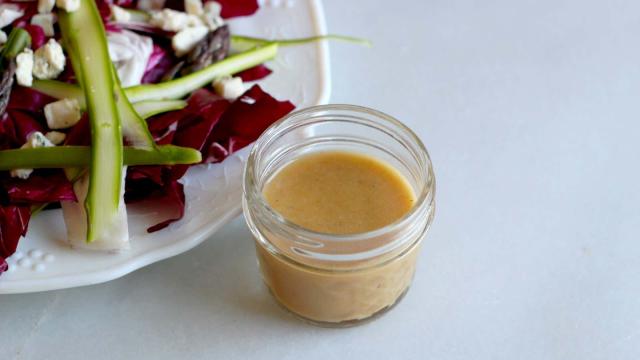There was a period of time, in the early and mid 2000s, when I ordered every salad with “oil and balsamic.” I would drizzle them on, one at a time, then gently toss the leaves with my fork to distribute evenly. It wasn’t good, but it made me feel in control of my diet (and calorie count), which was very important to me in the early and mid 2000s.
These salads were, in a word, joyless, mainly because oil and vinegar work far better together than they do separately. And when I say “together,” I don’t mean “on the same plate,” I mean “emulsified into a vinaigrette.”
That’s really all a vinaigrette is — an often tenuously stable emulsion of vinegar (an aqueous solution of acidic acid and, sometimes, flavourings) and oil (a fat). Aqueous solutions and fats do not like hanging out together all that much, but allowing them to drift apart (or pouring them on separately, as I did in my youth) can wreak havoc on your salad.
It’s not just a matter of aesthetics. According to Serious Eats, un-emulsified oil can literally wreck your greens:
It’s like this: lettuces grow outdoors in places where it rains. In order to protect themselves, lettuce leaves have a thin, waxy, water-resistant coating on their surface. What this means for us in a culinary sense is that water-based liquids like vinegar or lemon juice run right off leaves, while oils tend to cling to them and cause them to soften and wilt.
Mix the oil and vinegar together, however, and the acid will stay suspended in the oil, which clings to the leaves, blessing them with flavour.
Obtaining proper emulsification can be challenging, especially if you don’t incorporate other ingredients or rely solely on a whisk. Luckily, you only need two things to make a perfectly emulsified vinaigrette: mustard and a mason jar.
Mustard helps out on a chemical level. The mucilage, which is present in the seed’s outer coating, is a natural emulsifier. It marries the hydrophilic and hydrophobic, forcing them to get along and stay together. The higher the mucilage, the longer your dressing will stay emulsified. (Yellow mustard doesn’t work all that well, but Dijon and stone-ground work wonders.) A good ratio is one part mustard to four parts oil and four parts vinegar.
The mason jar (or any jar with a lid) is the other key player. Jars are my favourite vinaigrette-making implement for several reasons, which I have explained previously, but will explain again, just to re-cap:
Not only do you probably already have one, but shaking dressing ingredients together gets them emulsified in a way even the most vigorous whisking cannot. You just pour, scoop or dollop your favourite vinaigrette ingredients into the jar, seal it, and shake until you have a homogeneous-looking mixture. Then you pour it on your salad. Then you eat your salad. Oh no, you made too much dressing? It’s a good thing it’s already in a sealable container. Just pop it in the fridge until you make another salad, which will be soon, because you’re very good at self-care.
Honestly, forget your whisk. Shake your vinaigrettes and you will never go back to whisking — or eating salads with un-emulsified oil and vinegar. (Seriously, it is such a bleak practice. Let’s leave it in the early and mid 2000s where it belongs.)

Leave a Reply
You must be logged in to post a comment.